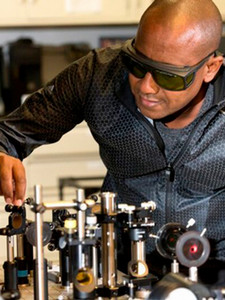OSE Seminar by Prof. Yohannes Abate on There’s Plenty of Interaction at the Bottom
Departmental News

Posted: November 2, 2024
Date: Thursday, November 07, 2024
Time: Noon to 1:00 PM
Location: PAIS Room 2540 and Zoom
Speaker:
Prof. Yohannes Abate
University of Georgia
Abstract:
The formulation of quantum mechanics in the late 1920s forever changed physics. More recently, quantum materials have emerged, presenting fascinating opportunities in condensed matter physics. Elementary interactions among elements such as electrons, phonons, and other quasiparticles in quantum materials give rise to the emergence of intriguing phases and offer enormous opportunities for the development of quantum technologies. However, investigating these interactions at the relevant length scale requires high-resolution methods beyond traditional far-field optical imaging and spectroscopy techniques, which are constrained by the diffraction limit of light. Interestingly, during the same period in the late 1920s, a visionary scientist named Synge introduced a groundbreaking concept that could circumvent the diffraction limit. Synge shared his idea with Einstein, who encouraged him to publish it. After many years of various pioneering works by different groups, a powerful modern nano-optical technique, a variant of Synge’s original idea, emerged. In this talk, I will introduce this technique and give examples of high-resolution probing of nanoscale physical phenomena and interactions in two classes of quantum materials: correlated oxides and van der Waals (vdW) crystals. Our recent results reveal how an applied field perturbs dopant distribution at the nanoscale in correlated oxides such as rare[1]earth nickelates (RNiO3 where R = rare-earth element), leading to ordered reconfigurable phases. This reconfigurability enables the design of robust artificial synapses and opens new frontiers for fundamental understanding of memory, learning, and information retention for brain-inspired information processing. Correlated oxides also provide exciting opportunities to reconfigure nano[1]photonic phenomena in vdW crystals, owing to their highly tunable local optical and electronic properties. In-plane vdW heterostructures composed of atomically thin monolayers with lateral interfaces, distinct from vertical heterostructures, can lead to intriguing physical phenomena arising from various interactions, including intralayer coupling, lateral strain, interface defects, spin-orbit interaction, correlated electronic fluctuations, and 2D alloys at interfaces. I will present recent results that provide quantitative insights into the role of these interactions in altering the complex dielectric function of 2D materials at the nanoscale.
Biography:
Yohannes Abate is the Susan Dasher and Charles Dasher MD Professor of Physics and (by courtesy) Chemistry at the University of Georgia and Founding Director of the Quantum Science & Engineering Program (https://quantum.uga.edu/). Abate’s condensed matter physics research interests include investigation of nanoscale and quantum phenomena and interactions in two[1]dimensional materials, oxide materials, and quantum emitters. Particularly his group is fascinated by how non-equilibrium or collective quantum phenomena that occur at the atomic scale result in nanoscale emergent behavior in quantum materials. His group implements various terahertz, infrared, optical spectroscopy and scanning probe techniques with diffraction unlimited spatial resolution. Professor Abate joined the University of Georgia (UGA) as an associate professor of physics in August 2017. He received his PhD in Physics at the University of Iowa in 2006. From 2006-2009 he was a postdoctoral research fellow at the University of California, Berkeley and Lawrence Berkeley National Laboratory. In September of 2009 he has spent time as a Visiting Scientist at the Nano-Photonics Laboratory, Max-Planck-Institut für Biochemie, Martinsried, Germany. Before joining UGA faculty, he was a member of the faculty (2014-2017) at Georgia State University and (2009-2014) California State University. His awards include The Gordon and Betty Moore Foundation Experimental Physics Investigator (2023), NSF Career Award (2016), Scialog Collaborative Innovative Award, Research Corporation for Science Advancement (2015), Most Valuable Professor, California State University, Long Beach (2014), Luis Alvarez Award for Best Experimental Research (American Physical Society CA Section) (2008) and The 2000 International Publication Award (University of the Philippines, Diliman) (2000). He received the BS degree in physics from Addis Ababa University, Ethiopia, and MS degree in physics from the National Institute of Physics, University of the Philippines, Diliman. He is a member of the American Physical Society and Materials Research Society
